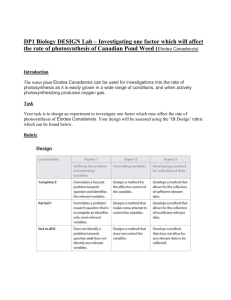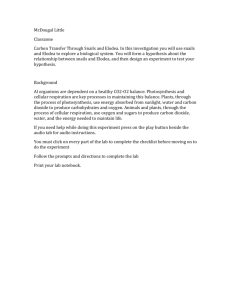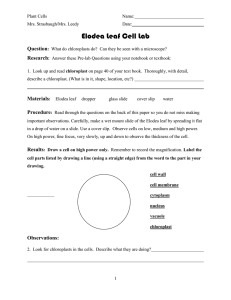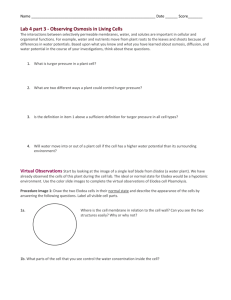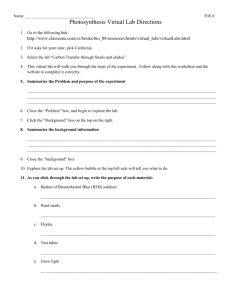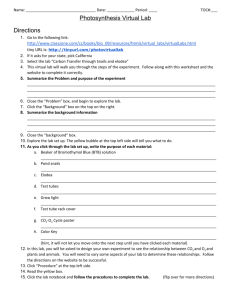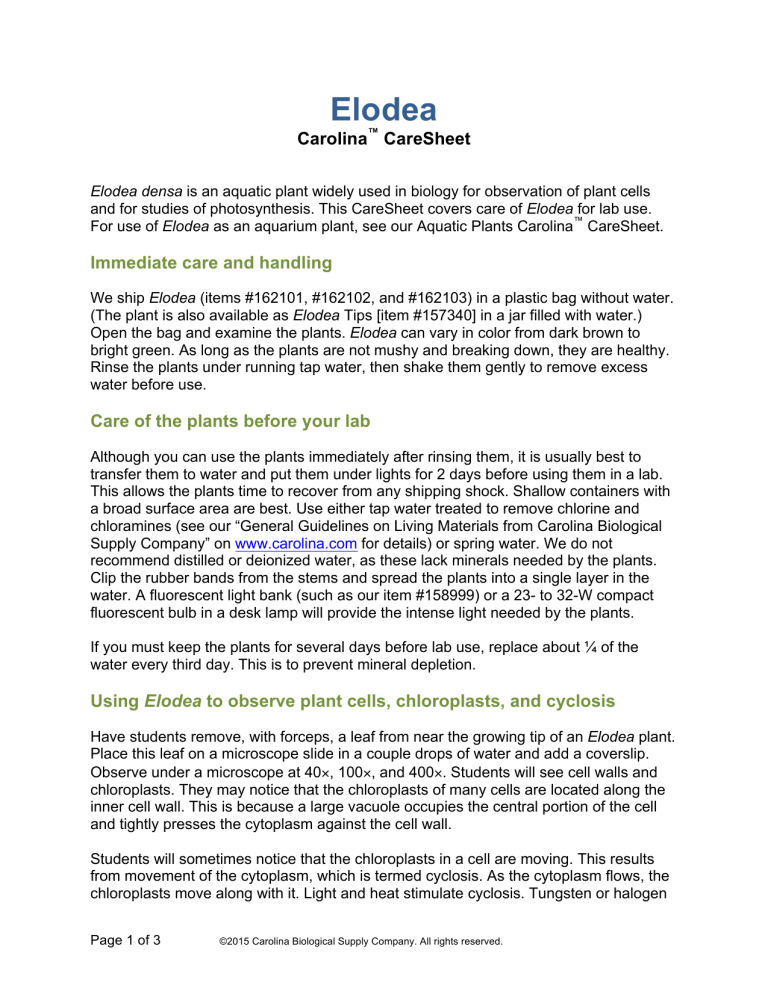
Elodea Carolina™ CareSheet Elodea densa is an aquatic plant widely used in biology for observation of plant cells and for studies of photosynthesis. This CareSheet covers care of Elodea for lab use. For use of Elodea as an aquarium plant, see our Aquatic Plants Carolina™ CareSheet. Immediate care and handling We ship Elodea (items #162101, #162102, and #162103) in a plastic bag without water. (The plant is also available as Elodea Tips [item #157340] in a jar filled with water.) Open the bag and examine the plants. Elodea can vary in color from dark brown to bright green. As long as the plants are not mushy and breaking down, they are healthy. Rinse the plants under running tap water, then shake them gently to remove excess water before use. Care of the plants before your lab Although you can use the plants immediately after rinsing them, it is usually best to transfer them to water and put them under lights for 2 days before using them in a lab. This allows the plants time to recover from any shipping shock. Shallow containers with a broad surface area are best. Use either tap water treated to remove chlorine and chloramines (see our “General Guidelines on Living Materials from Carolina Biological Supply Company” on www.carolina.com for details) or spring water. We do not recommend distilled or deionized water, as these lack minerals needed by the plants. Clip the rubber bands from the stems and spread the plants into a single layer in the water. A fluorescent light bank (such as our item #158999) or a 23- to 32-W compact fluorescent bulb in a desk lamp will provide the intense light needed by the plants. If you must keep the plants for several days before lab use, replace about ¼ of the water every third day. This is to prevent mineral depletion. Using Elodea to observe plant cells, chloroplasts, and cyclosis Have students remove, with forceps, a leaf from near the growing tip of an Elodea plant. Place this leaf on a microscope slide in a couple drops of water and add a coverslip. Observe under a microscope at 40×, 100×, and 400×. Students will see cell walls and chloroplasts. They may notice that the chloroplasts of many cells are located along the inner cell wall. This is because a large vacuole occupies the central portion of the cell and tightly presses the cytoplasm against the cell wall. Students will sometimes notice that the chloroplasts in a cell are moving. This results from movement of the cytoplasm, which is termed cyclosis. As the cytoplasm flows, the chloroplasts move along with it. Light and heat stimulate cyclosis. Tungsten or halogen Page 1 of 3 ©2015 Carolina Biological Supply Company. All rights reserved. substage lamps produce both heat and light, and after 2 to 3 minutes students will begin to observe cyclosis. If your microscopes have fluorescent or LED lamps, these produce very little heat and often will not stimulate cyclosis. To provide the needed heat, use a desk lamp equipped with a halogen bulb. Position the lamp so that it shines down on the lab bench. After a few minutes, the surface of the lab bench should become noticeably warm to the touch. Students can place their slides on this warm surface for 3 minutes and then observe for signs of cyclosis. A somewhat better arrangement is to position the lamp so that it shines directly onto the stage of a microscope, thus heating the slide as students view it. Although not all slides may show cyclosis, enough will so that students can share them and see the movement. Substitutes for Elodea densa Several states ban Elodea densa. If you live in one of those states, we must ship you a substitute. Here is some information on the plants we commonly send as substitutes. • Elodea canadensis (item #162111): This native plant is similar in appearance to E. densa but is a smaller plant and the leaves typically do not cluster as closely on the stem. Students can observe cells, cell walls, and cyclosis as with E. densa. E. canadensis is a good oxygen producer for studies of photosynthesis and can be shipped to most states. It is often unavailable in the winter months. • Elodea najas: Almost identical in appearance to Elodea densa and can substitute for all uses of that plant. Students can observe cells, cell walls, and cyclosis as with E. densa. E. najas is a good oxygen producer for studies of photosynthesis and can be shipped to all states. There are times when it is unavailable. • Chara (item #162120): The plants (Chara is a multicellular green algae) consist of stems with whorls of branchlets. It is a good oxygen producer for studies of photosynthesis. When viewed under magnification, the internodal cells (stems) show cyclosis; however, this is visualized as streaming of granules within the cytoplasm, not as movement of chloroplasts. The large chloroplast, which forms a background of green, does not move. Chara can be shipped to all states. Chara often has a strong odor, something like garlic. This does not indicate that the plants are dead or decaying. Disposal Elodea densa is a non-native plant that is invasive in many areas. After lab use, add leftover plants to an aquarium. Otherwise, seal the plants in a plastic bag, freeze, and discard the unopened bag in the trash. Page 2 of 3 ©2015 Carolina Biological Supply Company. All rights reserved. FAQs How can I use Elodea to study photosynthesis? During photosynthesis, the plant absorbs carbon dioxide from the water and releases oxygen. Since oxygen is much less soluble in water than is carbon dioxide, the water quickly saturates with oxygen and bubbles form. The number of bubbles released per minute measures the rate of photosynthesis. Alternately, use a simple volumeter to measure the increase in volume of gas caused by the release of oxygen. What is the difference between Elodea (item #162101) and Elodea Tips (item #157340)? Elodea (item #162101) consists of Elodea sprigs that are about 11 cm (4¼”) in length. We recommend these for aquarium plants and for studies of photosynthesis, although they can be used also for cell studies. Elodea Tips (item #157340) are the terminal 3- to 4-cm ends cut from sprigs. We recommend these as best for cell studies. Can I substitute other plants for Elodea densa? For photosynthesis studies, almost any aquatic plant will work. These include Ludwigia (item #162141), Cabomba (item #162022), Myriophyllum (item #162161), Ceratophyllum (item #162041), and Sagittaria (item #162201). For easy viewing of plant cells with chloroplasts, consider Fern Prothallia (item #156877). Problems? We hope not, but if so, contact us. We want you to have a good experience. Orders and replacements: 800.334.5551, then select Customer Service. Technical support and questions: caresheets@carolina.com www.carolina.com © 2015 Carolina Biological Supply Company Page 3 of 3 ©2015 Carolina Biological Supply Company. All rights reserved.

